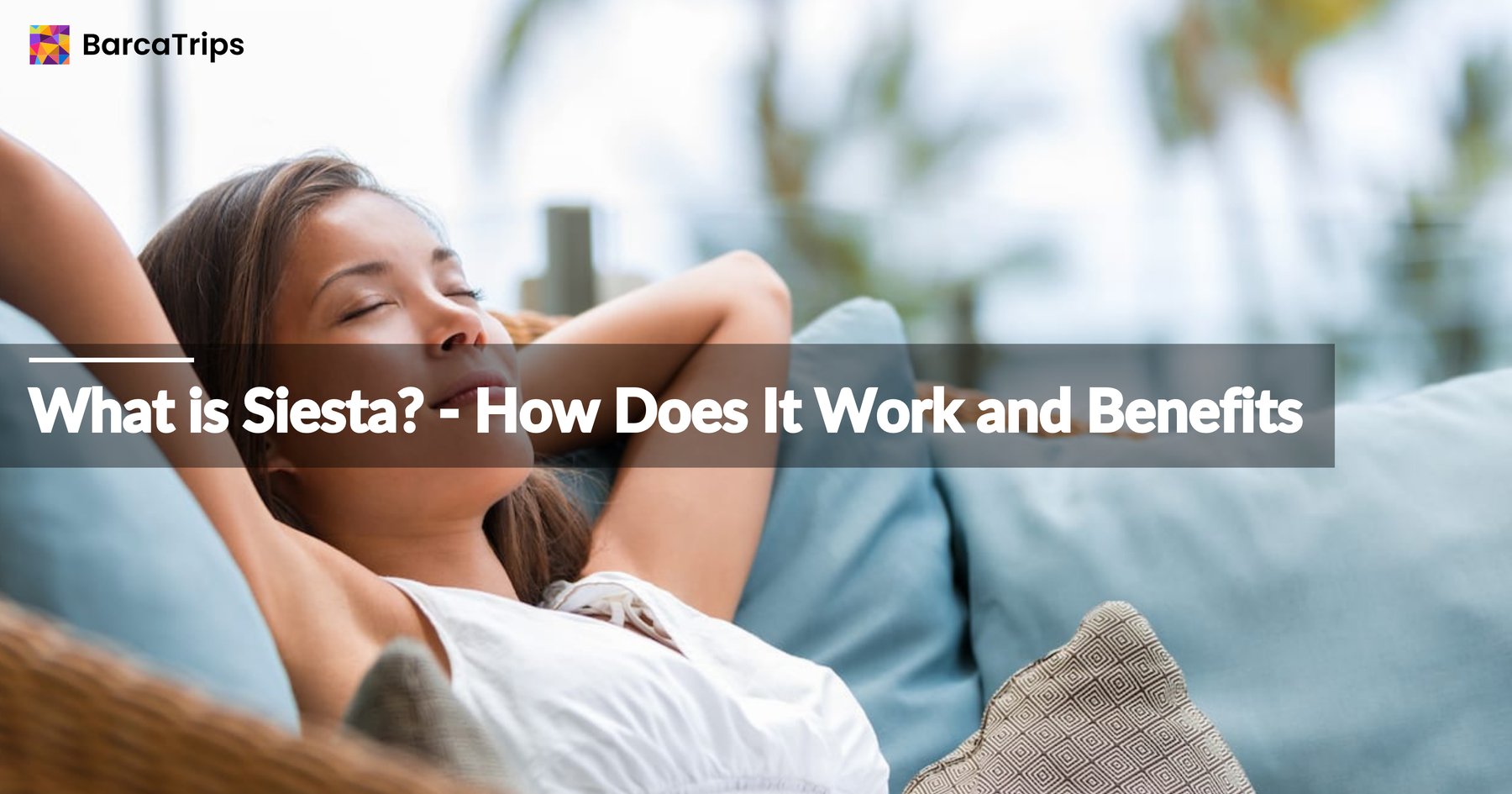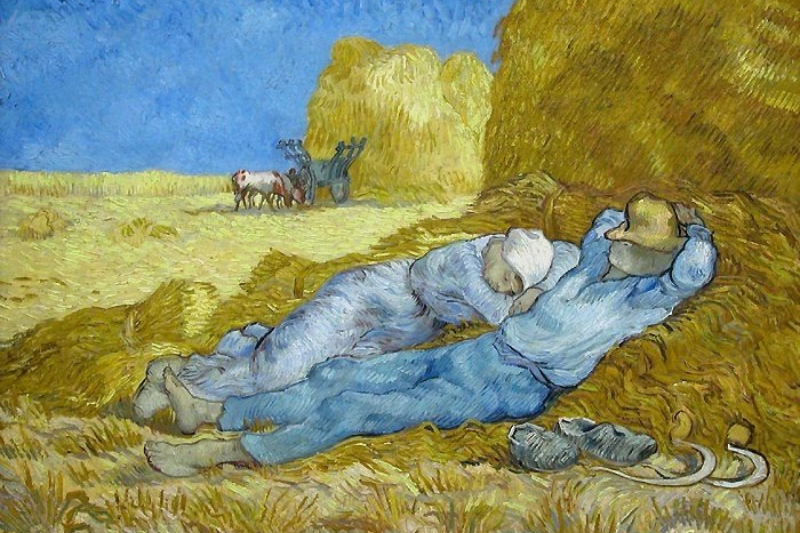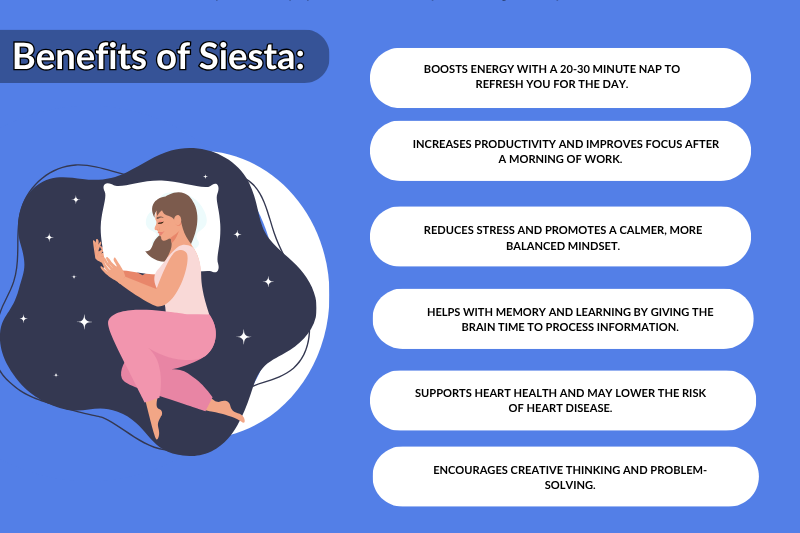What is Siesta? - How Does It Work and Benefits


When most people think of Barcelona, they picture Gaudí buildings, sunny beaches, and delicious tapas. But there’s one little habit that still surprises visitors: the siesta. It’s not just a nap, it’s a whole rhythm of life that makes this city feel a little more relaxed.
The Origins of the Siesta

The Siesta (Van Gogh)
The siesta has been part of life in Spain for over 2,000 years. The word comes from the Latin phrase hora sexta, which means “the sixth hour” and refers to midday, when the sun is at its highest. At that time, people would step away from work to rest and cool down.
The habit began in ancient Rome and eventually reached Spain, where it made a lot of sense. Imagine working outdoors with no air conditioning during the hottest part of the day. Of course people needed a break. Farmers and laborers would stop, eat, rest, and often nap before returning to work later, once the heat had eased.
But siesta wasn’t just about escaping the sun. In Spain, lunch is the biggest meal of the day and is often enjoyed with a glass of wine. After a big meal like that, your body slows down. A nap helps with digestion and gives you energy to get through the rest of the day.
What started as a practical pause became a cultural habit. Today, siesta is still part of the rhythm of daily life in Spain. It’s a small way to bring balance into a busy day and slow down, even if just for a little while.
How Siesta Fits into Modern Barcelona Life
Siesta is often linked to Spain’s relaxed way of life, but in a busy city like Barcelona, the way people take this break has changed. Traditionally, siesta meant resting after a big lunch and avoiding the afternoon heat. These days, though, not everyone naps.
In Barcelona, many shops and businesses still close for a few hours in the afternoon, usually from around 2 PM to 4 or 5 PM. But that doesn’t mean everyone goes home to sleep. For most locals, it’s just a chance to slow down—have lunch with friends or family, run a few errands, or take a breather before heading back to work. Lunch is the biggest meal of the day here, and it’s meant to be enjoyed. No rushing, no eating at your desk.
That said, things are a bit different in the city center. Big stores, malls, and international chains usually stay open all day, especially in tourist-heavy areas. But if you wander into quieter neighborhoods, you’ll still find small shops closed in the afternoon.
Even if naps aren't as common anymore, the idea behind siesta hasn’t gone away. It’s still a moment to pause, recharge, and take life at a slower pace. That balance between work and rest is part of what gives Barcelona its charm—and makes it feel different from the non-stop rush of other major cities.
The Benefits of Taking a Siesta and Why You Should Also Incorporate It

Taking a siesta is more than just a chance to rest—it can significantly boost your energy and productivity. A short nap of 20-30 minutes in the afternoon helps improve focus and mental clarity. It can help you tackle the rest of the day with renewed energy. It’s a simple way to recharge when your energy dips after a busy morning.
Siestas also play a big role in reducing stress and improving well-being, both physical and mental. By taking a break, you give your mind a chance to reset, which lowers cortisol levels and helps you feel more relaxed. Additionally, napping supports heart health by lowering blood pressure and can even improve memory and learning, helping your brain consolidate information more effectively.
Incorporating a siesta into your routine doesn’t require living in Spain. Just a short, restful break during the day can make a difference. Whether it’s a power nap, meditation, or simply unplugging for 20 minutes, a siesta helps you slow down, balance work and relaxation, and improve your overall health.
Read all the benefits of napping midday, created by medical professionals.
Siesta Myths - True or False
When people think of siesta, they often picture entire cities shutting down for long afternoon naps, but that's far from the truth, especially in modern Spain.
❌Everyone is Asleep
One common myth is that everyone takes a nap during siesta, but in reality, many Spaniards—especially those in big cities like Barcelona—rarely have time for one. In fact, statistics show that more than half of the population never naps, and siestas are more common among retirees and young children.
❌Everything is Closed
Another misconception is that everything closes during siesta time. While some small shops and businesses may shut down in the afternoon, it’s mainly for long lunch breaks, not for sleeping. Large stores, malls, and most restaurants in busy areas stay open all day. Mainly the ones who cater to tourists. The closure you might notice is more about enjoying a leisurely meal than taking a nap.
❌Siesta is Only About Sleep
Lastly, siestas aren’t only about sleep. It’s a broader tradition that allows people to take a break and recharge. Whether it’s relaxing with family, grabbing a coffee, or simply escaping the afternoon heat, siesta time is about finding balance and slowing down, not necessarily hitting the pillow.
Final Tips
As a tourist in Barcelona, you don’t need to sleep through siesta time to enjoy it! Instead, embrace the slower pace of life that defines this tradition. Between 2 PM and 5 PM, when locals take their break, plan to enjoy a long, relaxed lunch at one of Barcelona’s many restaurants. This is when you can savor the city's culinary delights without rushing—an essential part of the local culture.
While some smaller shops may close during the afternoon, many attractions like museums, major landmarks, and larger stores remain open. This makes it the perfect time to explore quieter spots like the Sagrada Família or take a leisurely stroll through a park, where you’ll find fewer crowds and a more peaceful atmosphere. Indoor attractions like museums are also a great way to escape the heat during this time.
If you prefer to rest, head back to your hotel or find a cozy café to unwind with a coffee or snack. Whether you choose to relax or explore, experiencing the siesta as a tourist gives you a taste of Barcelona’s more laid-back, balanced way of life.
FAQs
What time do restaurants close for siesta in Barcelona?
Most restaurants in Barcelona typically close after lunch, around 4 PM, and reopen for dinner service around 8 PM. However, many casual eateries and tapas bars stay open throughout the day, so you won’t have trouble finding a place to eat.
Do shops close during siesta in Barcelona?
In Barcelona, smaller shops may close for siesta between 2 PM and 5 PM, especially in quieter areas. However, larger stores, malls, and tourist-focused shops often remain open all day without any breaks.
Does Spain have siesta every day?
Siesta is still a common tradition in Spain, but it isn’t practiced by everyone daily. In modern cities like Barcelona, most people don’t take a nap every day, and businesses in busy areas may remain open. Siesta is more common in smaller towns and rural areas.
Is siesta healthy?
Yes, siestas can be very healthy! A short nap of 20-30 minutes can boost energy, improve focus, reduce stress, and even support heart health. It's a great way to recharge, especially after a large meal or during the hottest part of the day.


